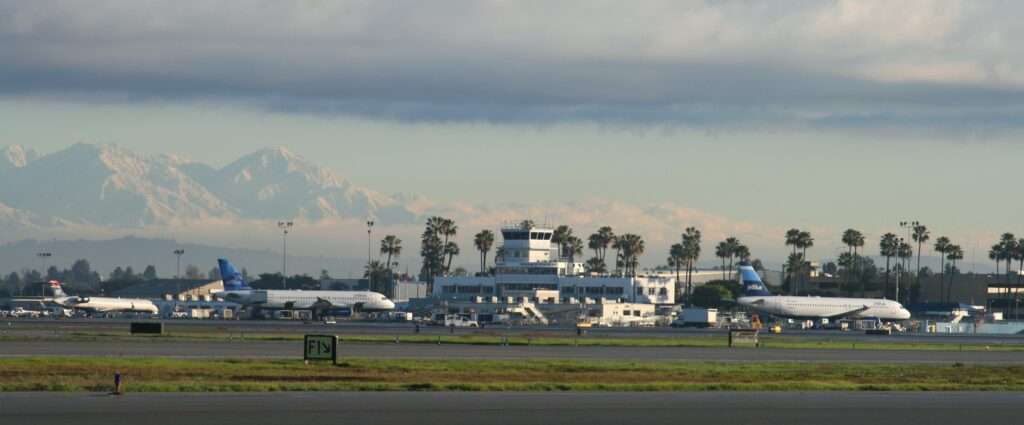Long Beach Airport (LGB), California, boasts a rich history intertwined with the evolution of aviation itself.
Nestled in Southern California, LGB’s story begins with the allure of flight and the foresight of a local aviation pioneer.
Early Days: Taking Flight on the Beach (1905-1923)
Long Beach’s love affair with aviation stretches back to 1905.
The city’s expansive, sandy beaches provided a natural landing strip for early aviators.
Hot air balloons and daring biplanes graced the skies, with Calbraith Perry Rodgers famously completing the first transcontinental flight in 1911, landing his “Vin Fiz” biplane on the very beach.
Enterprising aviator Earl S. Daugherty saw the potential in Long Beach.
In 1919, he established the world’s first flight school, the Daugherty School of Aviation, at the future site of LGB.
Daugherty’s school, offering air shows, stunt flying, and passenger rides, thrived, attracting not only thrill-seekers but also the attention of city officials.
Recognizing the burgeoning aviation industry’s potential, the Long Beach City Council partnered with Daugherty to establish a dedicated municipal airport.
Birth of an Airport: Daugherty Field and the Rise of Commercial Aviation (1923-1941)
In 1923, the City Council purchased land near the intersection of Spring and Cherry Streets, breaking ground on what would become Long Beach Airport.
Officially dedicated in December 1924, the airport was initially named Daugherty Field in honor of its visionary founder.
Furthermore, the new airport flourished.
The oil boom of the 1920s fueled growth, and by 1925, private plane owners were leasing space.
Recognizing the strategic location, the City Council strategically attracted the military.
Furthermore, hangars and administrative facilities were built for both the U.S. Navy (1928) and the U.S. Army Air Corps (1930), establishing Long Beach, California as a vital military base.
Civilian aviation also took off.
1925 saw the first airmail service between Long Beach and New York, taking just two days.
By 1928, LGB became the first illuminated airport in the country, extending its operational hours.
Furthermore, major airlines like American, United, TWA, and Western began service in 1938, solidifying LGB’s position as a major commercial hub.
The iconic Streamline Moderne terminal, designed by William Horace Austin and Kenneth Smith Wing, opened in 1941.
This architectural style, with its emphasis on curved lines and horizontal elements, reflected the dynamism and modernity of the aviation age.
Overall, the terminal, declared a Historic Landmark in 1990, remains a defining feature of LGB today.

World War II and Beyond: LGB’s Role in the Global Conflict and Commercial Expansion (1941-1970)
World War II transformed LGB in California.
The airport became a critical training ground for pilots and a staging area for aircraft deployment.
Notably, the Women’s Auxiliary Ferry Squadron (WAFS) and Women Airforce Service Pilots (WASPs) played a crucial role at LGB, ferrying military aircraft across the country.
The Douglas Aircraft Company also established a factory near the airport, further solidifying LGB’s role in the war effort.
Furthermore, post-war, commercial aviation boomed.
The jet age ushered in a new era of travel, and LGB continued to expand its service.
Also, passenger numbers soared, and new airlines like JetBlue and Southwest established themselves at LGB, offering a wider range of destinations.
Modernization and Challenges: Adapting to a Changing Aviation Landscape (1970-Present)
The latter half of the 20th century brought both growth and challenges for Long Beach, California.
The airport faced competition from larger regional hubs like Los Angeles International Airport (LAX).
However, LGB capitalized on its convenience and focus on short-haul flights, catering to business travelers and leisure destinations.
Furthermore, the airport also underwent significant modernization efforts.
New terminals were built, runways were extended, and noise abatement measures were implemented to address concerns from nearby residents.
LGB continues to strike a balance between serving its community and maintaining its position as a vital transportation hub.
Today, LGB remains a busy airport, serving millions of passengers annually.
Overall, with ongoing renovations to the historic terminal and a focus on sustainability, LGB looks towards the future, ready to continue its legacy as a cornerstone of Southern California aviation.

Click the banner to subscribe to our weekly newsleter.

Click the photo to join our WhatsApp channel so then you can stay up to date with everything going on in the aviation industry!









